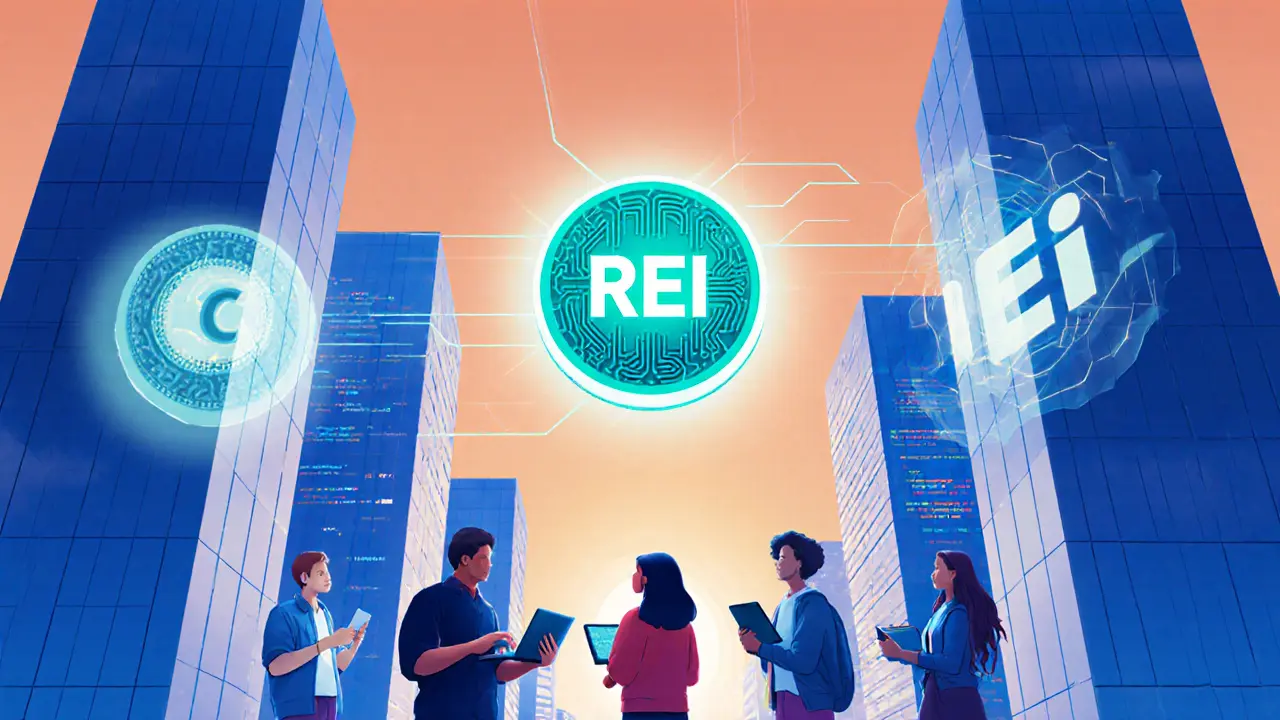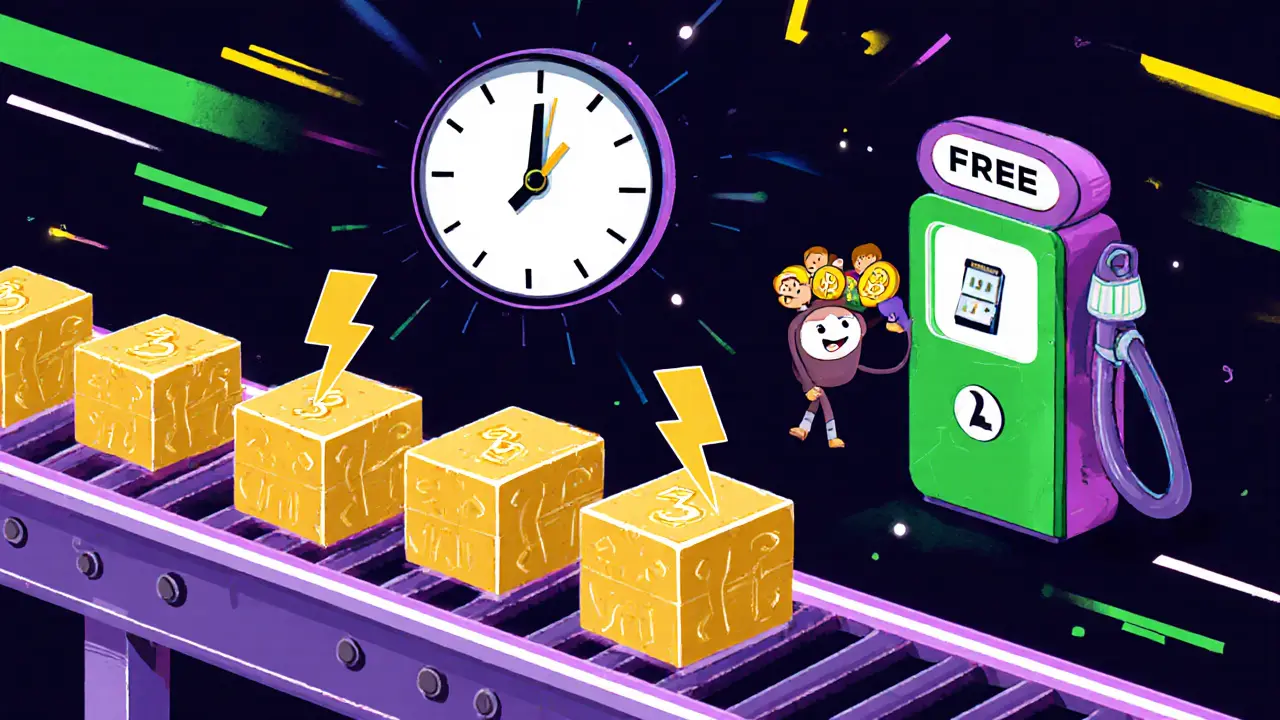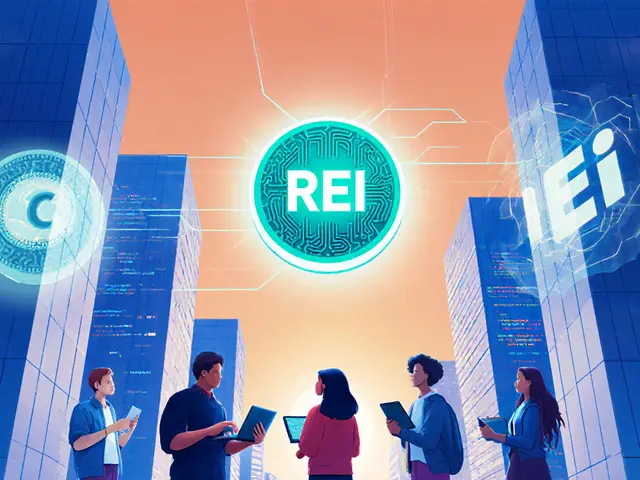What Is REI Network (REI) Crypto Coin? Explained

REI Network Token Value Calculator
Current REI Network Statistics
Current Price: $0.0152
Market Cap: $15 million
Total Supply: 1 billion REI
Circulating Supply: 950 million REI
24h Volume: $825K - $1M
All-Time High: $0.3575
Token Value Calculator
Projected Value After 1 Year(s):
Current Value: $0.00
Projected Value: $0.00
Price Forecast Summary
| Year | Estimated Price | Price Range |
|---|---|---|
| 2026 | $0.1249 - $0.1495 | +720% - 885% |
| 2028 | $0.1350 - $0.2292 | +800% - 1400% |
| 2029 | $0.5146 | +3300% |
| 2041 | $2.26 | +14800% |
* These projections are speculative and should not be considered financial advice.
If you’ve heard the name REI Network and wonder what it actually does, you’re in the right place. This guide breaks down the blockchain’s origins, how its coin works, and why it matters for developers and investors alike.
Key Takeaways
- REI Network evolved from the GXChain project to become an EVM‑compatible, fee‑free blockchain.
- Blocks are produced every 3 seconds, enabling over 3,000TPS.
- The native token, REI, has a 1billion total supply and offers up to 10% APR for a one‑year staking commitment.
- Free‑gas transactions are possible thanks to a staking‑based resource model.
- Partnerships with TAN, InfluxAI, CrossFi and PathPulse AI expand REI’s use cases across DeFi, GameFi and NFTs.
Background and Evolution
REI Network is a decentralized public blockchain platform that originated from the former GXChain project. The shift from GXChain to REI Network was driven by the need for a lighter, more versatile architecture that could run on devices using Node.js and other popular languages. By redesigning the core protocol, the team achieved full compatibility with the Ethereum Virtual Machine (EVM), allowing developers to port existing dApps with minimal changes.
The original GXChain token (GXC) was swapped at a 1:10 ratio for the new REI token. This conversion gave early GXC holders a straightforward upgrade path while boosting liquidity for the rebranded ecosystem.

Technical Specs
Speed and scalability are central to REI Network’s promise. The blockchain finalizes a block roughly every 3 seconds, delivering a theoretical throughput of more than 3,000transactions per second (TPS). This performance is comparable to many layer‑2 solutions while keeping the network fully on‑chain.
One of the most noticeable features is the free‑gas model. Instead of paying transaction fees in the native token, users stake REI to obtain on‑chain resources. The staking mechanism allocates a portion of the network’s capacity to each staker, effectively covering gas costs for their transactions.
Below is a quick side‑by‑side look at how REI Network stacks up against its predecessor and a major competitor:
| Feature | REI Network | GXChain | Ethereum (Mainnet) |
|---|---|---|---|
| Block time | ~3seconds | ~5seconds | ~12‑14seconds |
| TPS | 3,000+ | ≈1,200 | ≈30 |
| Gas model | Free‑gas via staking | Standard gas fees | Standard gas fees |
| EVM compatible | Yes | No | Yes |
| Total supply | 1billion REI | 10billion GXC | ≈120million ETH |
Tokenomics and Market Data
The native REI token drives both utility and governance. With a capped supply of 1billion, about 950million REI are circulating, according to recent market data. Stakers can earn annual returns up to 10% APR when they lock their tokens for a full year and vote for validators.
Current pricing hovers around $0.0152USD per REI, giving the network a market cap near $15million. Daily trading volume sits between $825k and $1M, indicating moderate liquidity. The all‑time high of $0.3575 was reached in March2024, followed by a 95% correction to present levels. The most recent low was $0.01341 in June2025, with a modest rebound since then.
Because the network uses a free‑gas model, transaction fees are effectively zero for users who stake. This design lowers barriers for newcomers and developers looking to test ideas without worrying about gas costs.
Ecosystem and Partnerships
REI Network’s ecosystem spans three main categories: Decentralized Finance (DeFi), GameFi and Non‑Fungible Tokens (NFT). By supporting the EVM, the platform can run any Solidity‑based smart contract, opening doors for a wide range of dApps.
Strategic partnerships amplify REI’s reach:
- TAN - provides blockchain‑level efficiency tools and cross‑platform support.
- InfluxAI - delivers Web3 security solutions, helping protect smart contracts.
- CrossFi - bridges fiat and crypto, making on‑ramps smoother for everyday users.
- PathPulse AI - integrates blockchain into smart‑city projects, showcasing real‑world utility.
Governance and Community
Decision‑making lives inside the REI DAO. Token holders can become validators, vote for other validators, and submit proposals that affect protocol upgrades, fee structures or ecosystem grants. Staking not only powers free gas but also grants voting weight, aligning incentives between network health and participant earnings.
The community speaks more than 13 languages, reflecting a truly global user base. For developers, the platform offers extensive documentation, tutorial videos, and a growth‑fund that can finance promising projects building on REI.
Future Outlook and Price Forecasts
Analysts at CoinLore project a range of possible price paths. By 2026, REI could trade between $0.1249 and $0.1495; 2028 estimates span $0.1350‑$0.2292; and a bullish 2029 scenario tops out near $0.5146. The most optimistic long‑term view sees a $2.26 valuation by 2041, though the model also warns of volatility, with potential lows as low as $0.0025 in some years.
These numbers are speculative and meant for information only. Real‑world performance will depend on continued development, partnership expansion, and the ability to attract dApps away from established chains.
Frequently Asked Questions
What makes REI Network’s gas model different?
Instead of paying per‑transaction fees, users stake REI to receive on‑chain resources that cover gas. As long as the stake is active, transactions are effectively fee‑free.
Can I move my GXChain (GXC) tokens to REI?
Yes. During the migration, each GXC token was swapped for 10 REI tokens at a 1:10 ratio.
Is REI Network fully EVM compatible?
Exactly. Smart contracts written for Ethereum run on REI without modification, which eases developer onboarding.
How do I become a validator on REI Network?
You need to stake a minimum amount of REI (the exact threshold varies with network parameters) and register your node through the REI DAO portal. Once approved, you start earning block rewards and transaction fees.
Where can I track REI’s price and on‑chain data?
Major sites like CoinMarketCap and CoinStats display the latest price, volume and market cap. The official REI Network website also publishes live statistics on wallet counts, total transactions and staked REI.

Andrew Lin
REI Network is just another meme coin trying to steal the limelight!
Caitlin Eliason
Honestly, the hype around REI feels like it’s trying to sell a dream that’s more fantasy than reality 😔. While the free‑gas model sounds appealing, the actual adoption numbers are still pretty modest. People need to understand that swaps from GXChain to REI were a one‑time event, not ongoing growth. The partnership list looks impressive, but many of those projects are still in early beta phases. I’m skeptical about the 10% APR claim; those rates are rarely sustainable without hidden risks. If you’re looking for a stable investment, there are better‑established options out there. The tokenomics seem sound on paper, but market dynamics can shift quickly. Keep an eye on the volume trends, they’ll tell you more than the glossy marketing material. Remember, high projected returns usually come with high volatility. Stay cautious and do your own research before diving in.
Franceska Willis
Okay, so REI’s free‑gas thing is cool, but have you actually tried a dApp on it? I tested a simple swap yesterday and the UI lagged like crazy, which kinda kills the "instant" vibe they brag about. Also, the community chat is flooded with bots pushing pump‑and‑dump schemes-definitely not the most welcoming environment for newbies. If you’re a dev, the EVM compatibility is nice, but you’ll still need to learn their staking‑resource model, which isn’t documented well. FYI, the token price is still way below the all‑time high, so if you’re a risk‑taker maybe it’s worth a look. Just don’t expect miracles overnight.
Nicholas Kulick
REI Network provides a fast block time (≈3 s) and a free‑gas model via staking, which can lower entry barriers for developers. The token supply is capped at 1 billion, with about 950 M circulating, giving a decent liquidity base. Stakers can earn up to 10 % APR when locking for a year, aligning incentives with network health. Its EVM compatibility means existing Solidity contracts can be ported with minimal changes. For investors, the current price is $0.0152, far below the ATH of $0.3575, indicating potential upside if adoption grows. However, volume is modest ($825K‑$1M), so price moves may be volatile. Overall, REI is an interesting project for those seeking a gas‑free environment and are comfortable with the risks of a smaller chain.
Heather Zappella
From a cultural perspective, REI’s effort to support multiple languages and global community is commendable. Their documentation includes tutorials in Mandarin, Spanish, and Arabic, which helps broaden outreach beyond the typical English‑centric crypto space. The partnership with CrossFi shows a real attempt to bridge fiat and crypto, potentially opening doors for everyday users. It’s also worth noting that the free‑gas model could be especially beneficial in regions where transaction fees are a barrier to entry. Keep an eye on how the REI DAO evolves, as community governance can shape future development paths. If the ecosystem expands, we might see more real‑world use cases emerging.
Kate O'Brien
Look, they’re hiding the fact that the whole free‑gas thing is just a front for heavy centralisation. All the gas is paid out of the staking pool, which means a few big whales can control the network’s capacity. They also claim to be “decentralised”, but the validator list is still dominated by the original team. If you’re not comfortable with that hidden power structure, stay away.
Ricky Xibey
Yo, REI’s block times are super quick, but the UI on their explorer is kinda clunky. Still, the staking rewards are decent if you lock for a year.
Sal Sam
The architecture leverages a DAG‑like consensus while preserving EVM compatibility, which is a clever hybrid approach. Their resource‑allocation model replaces per‑transaction gas with staking‑derived bandwidth, reducing friction for dApp developers. However, the token economics could suffer from inflation if staking participation drops, as the reward pool is funded by new REI emissions.
Marcus Henderson
It is evident that REI Network aspires to address high transaction fees that plague many layer‑1 solutions. While the projected price ranges appear optimistic, the network’s success will largely depend on the adoption of its free‑gas model by developers. The partnership ecosystem suggests a strategic effort to broaden use‑cases. Nonetheless, potential investors should remain vigilant regarding market volatility.
Melanie LeBlanc
REI Network presents an intriguing blend of speed, scalability, and a novel fee model that could reshape how users interact with blockchain applications. First, the block time of roughly three seconds places it among the faster public ledgers, allowing for rapid transaction finality. Second, the touted throughput of over three thousand transactions per second is a substantial improvement over legacy chains that struggle to exceed a few dozen. Third, the free‑gas mechanism, powered by staking, effectively removes the financial barrier that deters many newcomers from exploring decentralized finance. Fourth, the token supply is capped at one billion, with a circulating supply that hovers around nine hundred fifty million, providing a clear picture of scarcity. Fifth, the staking rewards of up to ten percent APR for a one‑year lock‑up offer a compelling incentive for holders to remain engaged with the network. Sixth, REI’s EVM compatibility ensures that developers can port existing Solidity contracts with minimal friction, fostering a smoother onboarding experience. Seventh, strategic partnerships with entities such as TAN, InfluxAI, CrossFi, and PathPulse AI broaden the ecosystem, potentially unlocking use‑cases across DeFi, GameFi, and even smart‑city initiatives. Eighth, the governance model via the REI DAO empowers token holders to influence protocol upgrades, fee structures, and ecosystem grants, aligning the community’s interests with the network’s health. Ninth, the current market price of $0.0152, which is significantly lower than its all‑time high of $0.3575, suggests ample upside potential should adoption accelerate. Tenth, the modest daily trading volume indicates that the market is still relatively thin, meaning price movements could be pronounced both upward and downward. Eleventh, the free‑gas approach, while innovative, relies on sustained staking participation; a decline could reintroduce fee pressures. Twelfth, the network’s focus on developer friendliness is demonstrated by comprehensive documentation and a growth‑fund that supports promising projects. Thirteenth, the global community, speaking more than thirteen languages, highlights the project’s international reach and cultural inclusivity. Fourteenth, the realistic projection tables, though speculative, provide a framework for investors to gauge potential returns. Fifteenth, the transparent tokenomics and clear staking parameters enhance trust among participants. Sixteenth, overall, REI Network stands out as a promising candidate for those seeking a high‑throughput, low‑cost blockchain solution, provided they remain mindful of the inherent risks associated with emerging ecosystems.
Jasmine Kate
Wow, another “rebranded” token trying to sound revolutionary while still being a copycat of everything else. The free‑gas gimmick is just a marketing ploy to get people to stake and lock up liquidity. Expect a pump‑and‑dump soon.
Jason Wuchenich
Hey folks, if you’re curious about REI, the staking APR can be a nice passive income stream, but remember that the price is still volatile. It’s wise to only allocate what you can afford to lose.
Lara Decker
Sure, the free‑gas model sounds sweet, but have you seen the validator centralization? A handful of nodes dominate, which defeats the decentralization claim.
Anna Engel
Oh great, another “groundbreaking” blockchain that will surely change the world… if only it could get past the 0.01 $ price barrier.
EDWARD SAKTI PUTRA
I’ve been watching REI’s community growth, and it’s encouraging to see developers actually building on the platform. The free‑gas approach really does lower entry costs for small projects.
manika nathaemploy
i think REI is kinda interesting but also risky, ppl should do their own research and not just follow hype.
Debra Sears
From an inquisitive standpoint, I’m curious how the staking‑based resource allocation will scale as the network grows. It would be useful to see more detailed analytics on usage patterns.
Matthew Laird
Let’s be real, the whole REI hype is just a distraction from the real issues in crypto. If you’re not buying the dip, you’re missing out, period.
Richard Bocchinfuso
i dont see why ppl are so hyped about REI when its just another copy of eth with a fancy free gas tagline.
Ken Pritchard
For anyone just getting started, consider looking at the official REI docs and the community forum; they provide step‑by‑step guides that make the onboarding process smoother.
Moses Yeo
Ah, the saga continues; REI promises free gas-yet the underlying economics are shrouded in mystery, prompting us to ask: is this a genuine innovation or a veneer masking systemic fragility?